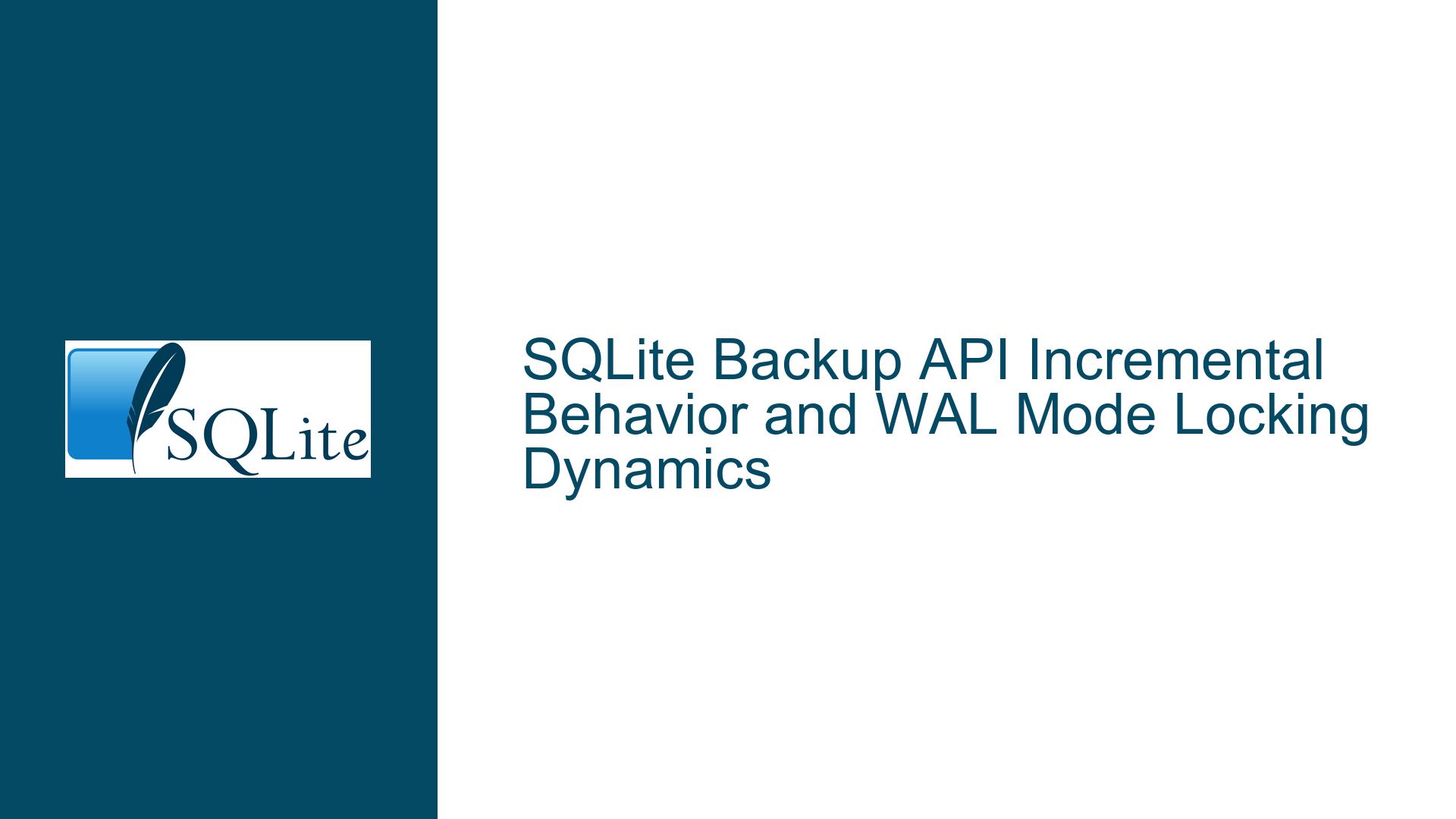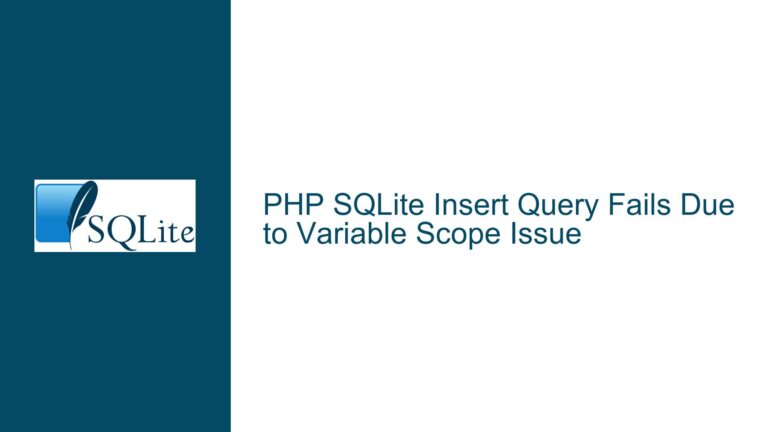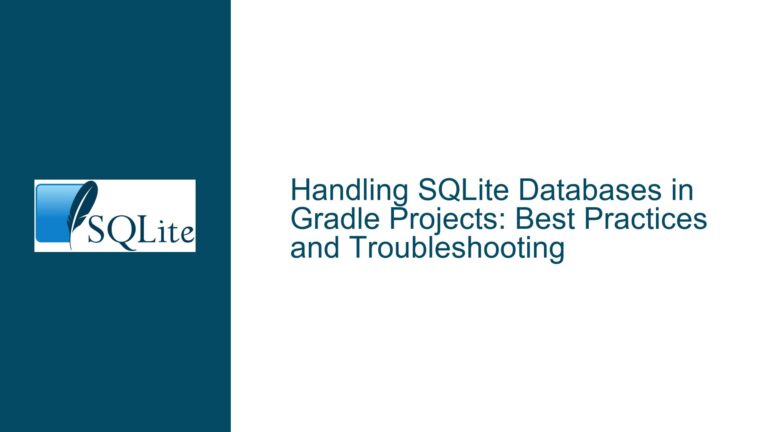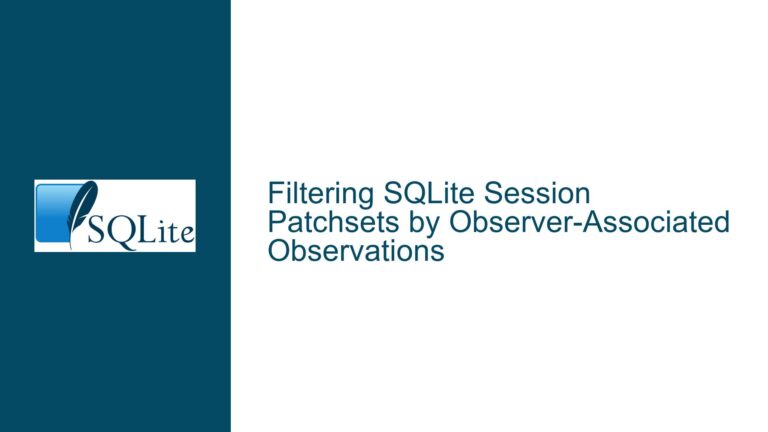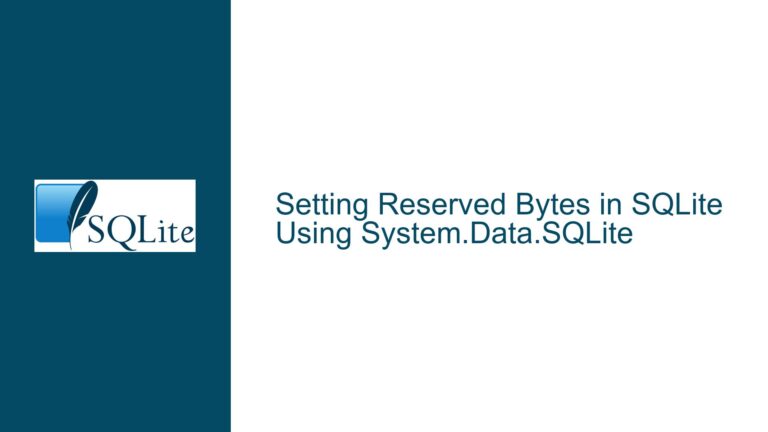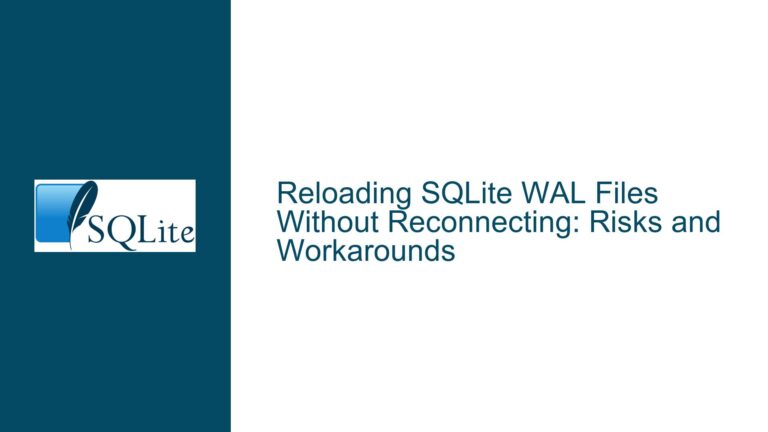SQLite Backup API Incremental Behavior and WAL Mode Locking Dynamics
Understanding SQLite Backup API Incremental Copying and Write-Ahead Logging Interactions
Core Mechanics of SQLite Backup Operations
The SQLite Backup API is designed to create copies of databases through a controlled process that balances efficiency with transactional integrity. A common misconception arises from the term "incremental backup," which implies differential copying (i.e., transferring only changes since the last backup). However, SQLite’s implementation operates differently: the Backup API copies all pages from the source database to the destination, but this process can be divided into smaller steps ("incremental" in execution time, not data volume).
When initiating a backup via sqlite3_backup_init(), the API creates a connection between the source and destination databases. The sqlite3_backup_step() function then drives the copying process. If called with a negative argument (e.g., sqlite3_backup_step(-1)), it attempts to complete the backup in a single operation. When using a positive integer argument (e.g., sqlite3_backup_step(100)), it copies the specified number of pages per call, allowing the backup to be interleaved with other operations.
The confusion in the forum thread stems from two critical factors:
- Locking Behavior: The Backup API acquires an exclusive lock on the destination database for the entire backup duration but only a shared lock on the source database during each
sqlite3_backup_step()call. - Concurrency and Restarts: If the source database is modified by an external process (a separate connection) during the backup, the operation restarts from the beginning on the next
sqlite3_backup_step()call. This reset ensures transactional consistency but negates progress made in prior steps.
Write-Ahead Logging (WAL) mode introduces further complexity. In WAL mode, readers and writers can coexist without blocking each other, but the Backup API’s interaction with WAL files and checkpointing alters the locking dynamics. Specifically, while a backup is in progress, the WAL file cannot be checkpointed, which affects how source database modifications propagate to the backup.
Why Backups Restart or Appear Non-Incremental
1. Misinterpretation of "Incremental" in Backup API Context
The term "incremental" in SQLite’s documentation refers to the execution granularity of the backup process, not data differentials. The API does not track changes between backup sessions or compute deltas. Instead, "incremental" describes the ability to split the copying of the entire database into multiple steps. For example, a 1,000-page database can be copied 100 pages at a time across 10 sqlite3_backup_step(100) calls. Each step involves locking the source database briefly, copying pages, and releasing the lock.
If a user expects the Backup API to skip unchanged pages during subsequent backups, this is a misunderstanding. Every backup operation—even when resumed—copies all pages anew.
2. External Writes Forcing Backup Restarts
When the source database is modified by a separate connection (not the one executing the backup), the Backup API detects these changes and restarts the backup. This occurs because SQLite cannot guarantee a consistent snapshot of the source database if external modifications interleave with backup steps.
For instance:
- Backup Connection: Executes
sqlite3_backup_step(100), copying pages 1–100. - External Writer: Inserts data into the source database, modifying page 150.
- Backup Connection: Calls
sqlite3_backup_step(100)again. The API detects that the source has changed externally, discards prior progress, and restarts from page 1.
This restart mechanism ensures the backup reflects a transactionally consistent state but can lead to repeated full copies if external writes are frequent.
3. Single-Connection Write-Backup Coupling
If the same connection handles both writes and backups, modifications made via that connection are reflected immediately in the backup. For example:
- Connection A initiates a backup and copies pages 1–100.
- Connection A inserts a row, modifying page 101.
- Connection A resumes the backup. The API recognizes the modification (since it originated from the same connection) and continues copying from page 101 onward.
This coupling prevents restarts but creates a backup that includes live changes, which may not be desirable for point-in-time snapshots.
4. WAL Mode and Checkpoint Interference
In WAL mode, writers append changes to the WAL file instead of modifying the main database directly. Readers (including backups) see the database as it existed at the start of their transaction. However, the Backup API operates at a lower level: it copies pages from the main database and the WAL file.
During a backup:
- The source database connection holds a read transaction open, preventing the WAL file from being checkpointed (i.e., merged back into the main database).
- If the WAL grows large, this can degrade read performance and increase backup time, as the Backup API must copy both the main database and the accumulated WAL pages.
Strategies for Efficient, Non-Blocking Backups
1. Validate Backup Step Granularity
Problem: Assuming sqlite3_backup_step(-1) is non-blocking.
Solution: Use sqlite3_backup_step(N) with a positive N to control lock duration.
- Step Size Selection: Choose a page count (
N) that balances backup progress with lock contention. SmallerNvalues reduce the time the source database is locked per step but increase the total number of steps. - Inter-Step Delays: Insert delays (e.g.,
sqlite3_sleep()) between steps to allow other connections to acquire locks.
Example Workflow:
sqlite3_backup *pBackup = sqlite3_backup_init(pDestDb, "main", pSrcDb, "main");
if (pBackup) {
do {
rc = sqlite3_backup_step(pBackup, 100); // Copy 100 pages
sqlite3_sleep(250); // 250ms delay between steps
} while (rc == SQLITE_OK || rc == SQLITE_BUSY);
sqlite3_backup_finish(pBackup);
}
2. Isolate Backup and Write Connections
Problem: External writes causing backup restarts.
Solution: Dedicate a connection solely for backups and prevent writes during the backup window.
- Read-Only Mode: Open the source database in read-only mode (
SQLITE_OPEN_READONLY) for the backup connection. This prevents accidental writes but does not block other connections. - Application-Level Locking: Use a mutex or semaphore in your application to pause writes during backup steps.
Example:
// Writer thread
pthread_mutex_lock(&backup_mutex);
// Perform write operations
pthread_mutex_unlock(&backup_mutex);
// Backup thread
pthread_mutex_lock(&backup_mutex);
sqlite3_backup_step(pBackup, 100);
pthread_mutex_unlock(&backup_mutex);
3. Leverage WAL Mode for Snapshot Backups
Problem: Blocking readers/writers during full backups.
Solution: Use WAL mode to decouple readers from writers and enable atomic snapshots.
- Checkpoint Before Backup: Force a WAL checkpoint to merge pending changes into the main database.
PRAGMA wal_checkpoint(TRUNCATE); - File-Based Copy: After checkpointing, copy the main database file directly. Since WAL mode allows concurrent reads, this copy will reflect a consistent state.
Caveat: Direct file copying is unsafe if writes occur during the copy. To avoid this:
- Open the source database in read-only mode.
- Copy the file while holding a read transaction.
Example:
sqlite3 *db;
sqlite3_open_v2("source.db", &db, SQLITE_OPEN_READONLY, NULL);
sqlite3_exec(db, "BEGIN;", NULL, NULL, NULL);
// Copy source.db to backup.db
sqlite3_exec(db, "COMMIT;", NULL, NULL, NULL);
4. Monitor Backup Progress and Restarts
Problem: Unnoticed backup restarts leading to prolonged backup times.
Solution: Track the sqlite3_backup_remaining() and sqlite3_backup_pagecount() functions to detect restarts.
- Progress Logging:
int remaining = sqlite3_backup_remaining(pBackup); int total = sqlite3_backup_pagecount(pBackup); printf("Copied %d of %d pages\n", total - remaining, total); - Restart Detection: If
remainingincreases unexpectedly, a restart has occurred. Investigate external write activity or lock contention.
5. Use SQLite’s Online Backup Utilities
Problem: Manual backup implementation errors.
Solution: Utilize prebuilt tools like sqlite3_backup or third-party libraries.
- sqlite3 Command-Line Tool:
echo ".backup 'backup.db'" | sqlite3 "source.db" - SQLite Backup Libraries: Frameworks like SQLiteC++ or SQLiteJDBC abstract backup APIs into higher-level functions.
Final Recommendations for Point-in-Time Snapshots
- WAL Mode + Checkpointing: For non-blocking backups, enable WAL mode and periodically checkpoint the WAL file before initiating a backup. This minimizes the data copied and ensures a consistent state.
- Dedicated Backup Window: Schedule backups during low-activity periods to reduce restart risk.
- File System Snapshots: On supported systems (e.g., NTFS, ZFS), use volume shadow copies to atomically capture the database file.
By aligning backup strategies with SQLite’s locking mechanics and WAL behavior, developers can achieve efficient, minimally disruptive backups without sacrificing data integrity.
